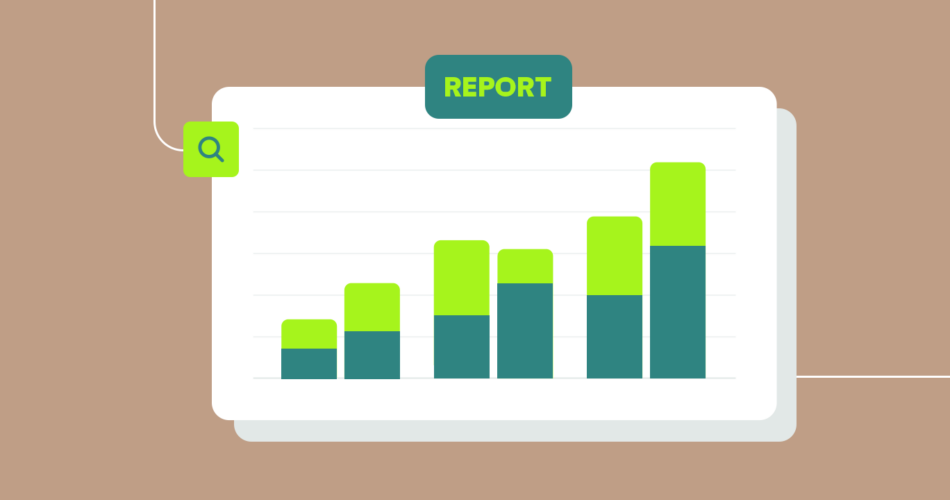Omnisend customers automate 32% of their email conversions. Are you maximizing sales?
Reading Time: 9 minutes
2021 was anything but a typical year.
Email marketers scrambled to prepare for Apple’s iOS 15’s impact on email marketing open rates. Supply chain challenges created an extended holiday shopping season and brands increased their attention to the importance of first-party data and opt-in marketing channels.
And while all of this was swirling in the background, they were trying to increase sales and maximize sales through established and maturing marketing channels.
Our annual ecommerce statistics report breaks down the performance of these increasingly important opt-in marketing channels, including email, SMS, and web push notifications.
Here are our key findings from this year’s ecommerce statistics report.
Email marketing
- Automated messages generated 29.6% of all email marketing orders but accounted for only 2.2% of email sends.
- iOS 15 impacted open rates as expected, causing them to increase 59% compared to the nine months before the update was released.
- The conversion rate for promotional email campaigns was 0.10%, a 14% YoY increase.
- 34% of consumers who click on an automated email go on to purchase compared to 7% of campaign email clickers.
- Email marketing generated 72 orders for every 1,000 promotional campaign emails clicked on compared to 343 orders for every 1,000 automated messages.
- Transactional messages continue to generate sales. Conversion rates for order confirmation and shipping confirmation messages increased 24% and 53% year-over-year, respectively.
SMS marketing
- SMS continues to grow. Promotional campaign sends increased 75% year-over-year while automated sends increased 258%.
- Conversion rates for promotional SMS campaigns were 0.25% (down 9.65% YoY) and 0.62% for automated SMS (an increase of 20.15% YoY).
- SMS drove 106% more orders in 2021 than in 2020.
Web push notifications
- Push message adoption is increasing. Merchants sent 396% more promotional messages and nearly 699% more automated messages than in 2020.
- Push messages generated 171% more orders compared to last year.
- 28% of consumers who click on a push notification message go on to purchase.
- Message performance remains strong. Campaign open rates are 27.6%, click rates 0.53%, and conversion rates 0.2%, while automated open rates are 64.2%, click rates 2.26%, and conversion rates 1.34%.
Methodology
For this report, we analyzed over 12 billion marketing emails, 63 million SMS, and 54 million web push messages sent by Omnisend merchants in 2021.
We calculated conversion rates by looking at attributed orders compared to total emails, SMS, and push messages sent. We calculated click rates by looking at the number of clicks compared to the number of emails, SMS, and push messages sent.
We also use the following terminology:
- Promotional campaigns: one-off messages manually sent by brands, such as promoting special offers, discounts, new products, and other promotional-style messages.
- Automated messages: messages triggered by user behavior, such as when a user abandons a cart, subscribes to a newsletter, or makes a purchase.
Automated messages generated 29.6% of all email marketing orders with only 2.2% of the sends.
2021 email marketing benchmarks
First, we looked at how email marketing fared in 2021, for both promotional campaigns and automated messages.
Email marketing conversion rates
Promotional campaign conversion rates ended 2021 up 14% year-over-year (YoY), finishing at 0.10%. Campaign conversion rates have now increased in consecutive years.
Automated messages saw a slight decrease of 2.8%, ending with a 1.9% conversion rate. Welcome messages (2.8%) and cart abandonment messages (2.4%) generated the two highest conversion rates of all automated emails sent in 2021.
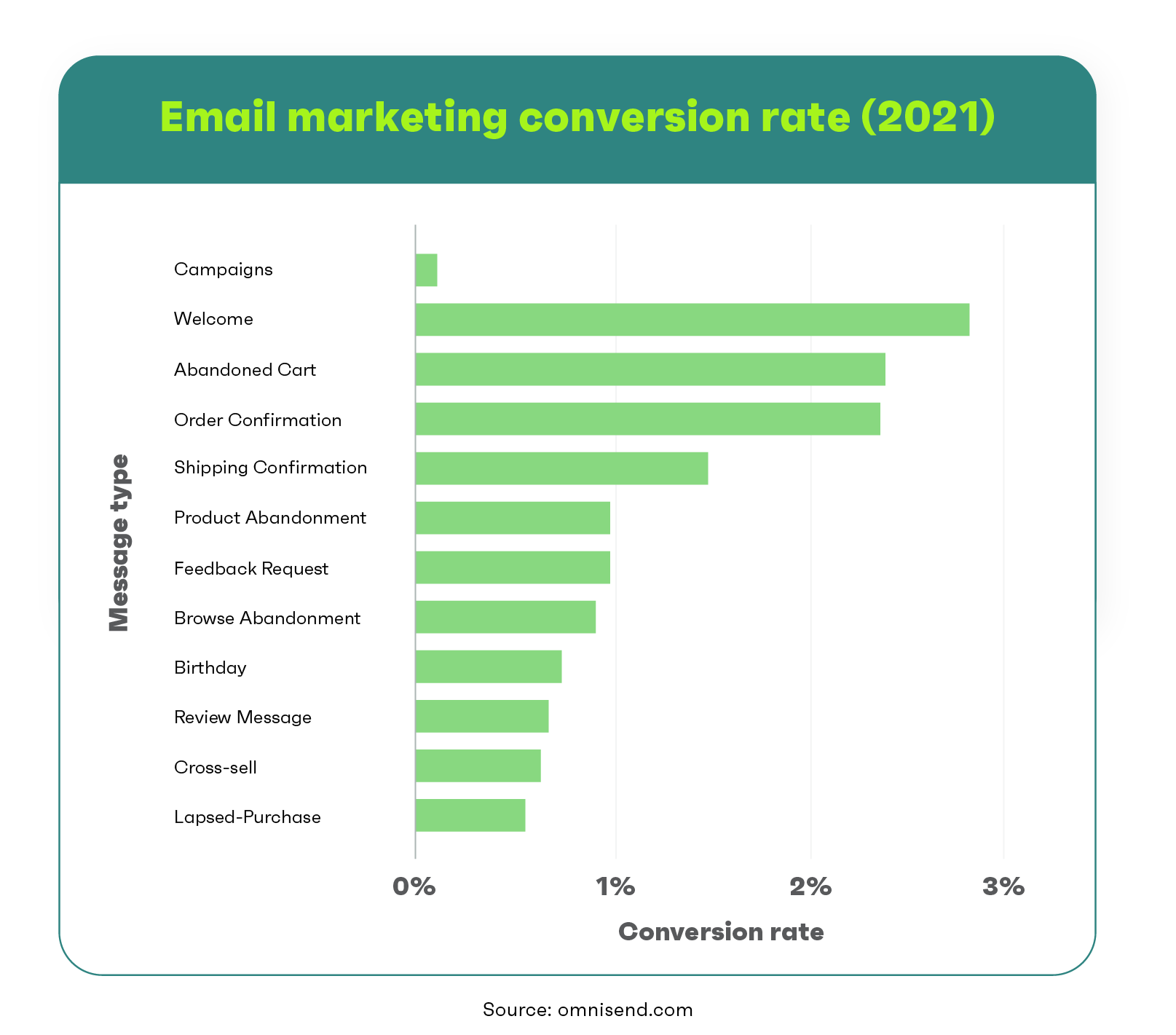
The decrease in conversion rate was largely propelled by lapsed-buyer and product review messages, which saw the two most significant YoY declines. On the other hand, abandoned cart messages saw the largest YoY increase (13%) of all non-transactional automated messages.
For transactional messages, order and shipping confirmation emails saw the most significant YoY increase in conversion rates. Order confirmation messages saw a 2.4% conversion rate, and shipping confirmation messages had a conversion rate of 1.5%, a 53% and 24% increase, respectively.
Message type
Conversion rate
YoY change %
Lift over campaigns
Campaigns
0.10%
45.02%
—
Abandoned cart
2.37%
12.93%
2299%
Birthday
0.72%
-4.01%
631%
Browse abandonment
0.90%
-6.51%
813%
Cross-sell
0.64%
-19.37%
553%
Feedback request
0.97%
-9.28%
887%
Lapsed-purchase
0.55%
-20.09%
460%
Product abandonment
0.98%
-16.65%
892%
Product review
0.66%
-23.96%
573%
Welcome
2.81%
-14.06%
2748%
Order confirmation
2.36%
53.04%
2289%
Shipping confirmation
1.48%
23.95%
1395%
Comparing automation conversion rates to campaigns, it is evident how impactful marketing automation is for ecommerce brands looking to increase their email marketing sales. Email marketing generated one order for every 1,000 promotional campaign emails sent compared to 19 orders for every 1,000 automated messages.
Key Takeaways: The decrease for low shopping intent messages (e.g., product review) and an increase for high intent messages (e.g., abandoned cart) reinforce the continuing trend of intent-based shopping. Ecommerce brands should:
- Create messaging that focuses on high customer intent, including welcome, cart abandonment, and browse and product abandonment messages.
- Use workflow splits to optimize their automated emails by splitting messages based on the abandoned cart total or purchasers’ history.
- Optimize transactional messages by including product recommendations and purchaser-only offers.
Email marketing click rates
The click rate for promotional campaigns ended 2021 at 1.37%, a YoY increase of 2.8%. Automated messages ended at 5.48%, a decrease of 15.7% year-over-year. This decrease may be attributed to the significant increase in and performance of automated SMS messages sent in 2021 (more on this below).
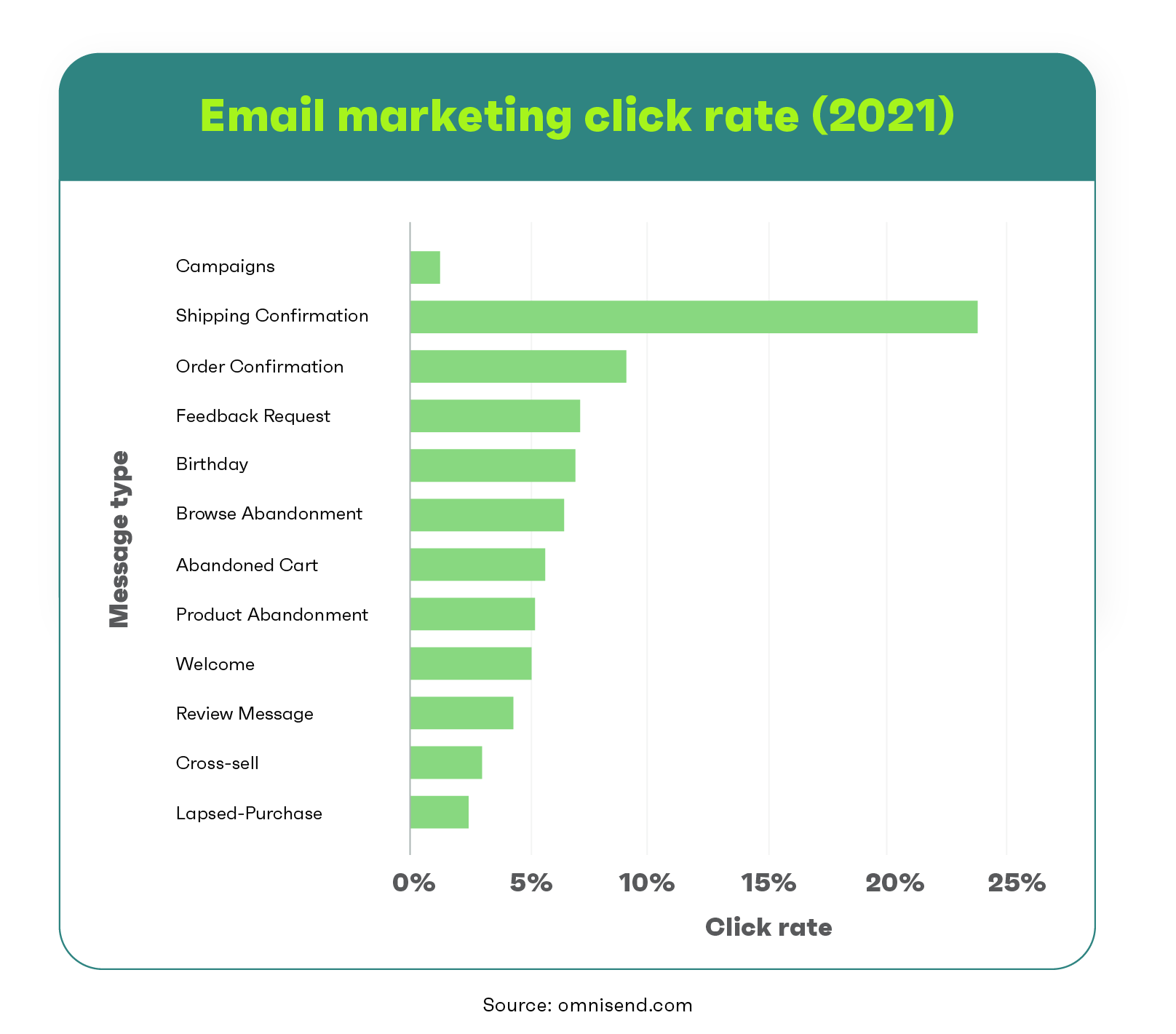
Even with the YoY dip, automated messages generate 300% more clicks than promotional campaigns—meaning relevant emails matter to shoppers. Digging a bit deeper, we see just how impactful automated messages are at driving consumer action.
- 34% of email subscribers who click on an automated email go on to make a purchase compared to 7% of campaign email clickers.
- Email marketing generated 72 orders for every 1,000 promotional campaign clicks compared to nearly 343 orders for every 1,000 automated message clicks.
| Message type | Click rate | YoY change % | Lift over campaigns |
| Campaigns | 1.37% | 2.77% | — |
| Abandoned cart | 5.73% | -7.36% | 317.79% |
| Birthday | 7.15% | 0.53% | 421.35% |
| Browse abandonment | 6.44% | 15.80% | 369.59% |
| Cross-sell | 3.09% | -19.13% | 124.84% |
| Feedback request | 7.20% | -11.77% | 424.95% |
| Lapsed-purchase | 2.58% | -20.82% | 87.72% |
| Product abandonment | 5.28% | -21.24% | 284.78% |
| Product review | 4.42% | 0.39% | 221.71% |
| Welcome | 5.23% | -17.07% | 280.75% |
| Order confirmation | 9.19% | -19.22% | 569.69% |
| Shipping confirmation | 23.60% | -10.65% | 1619.51% |
Key Takeaways: Click rates are strong for both campaigns and automations. Brands should:
- Optimize their messages to maximize click opportunities, such as by emphasizing their competitive differentiators.
- Increase the number of automated messages to maximize relevant click opportunities.
- Make a concentrated effort to grow their SMS list and add SMS marketing to their automated workflows, giving consumers more opportunities to engage with messages.
Email marketing open rates
Open rates for promotional campaigns increased 45% YoY, finishing the year at 14.7%. Automated messages finished at 33.8%, a 3.8% YoY increase.
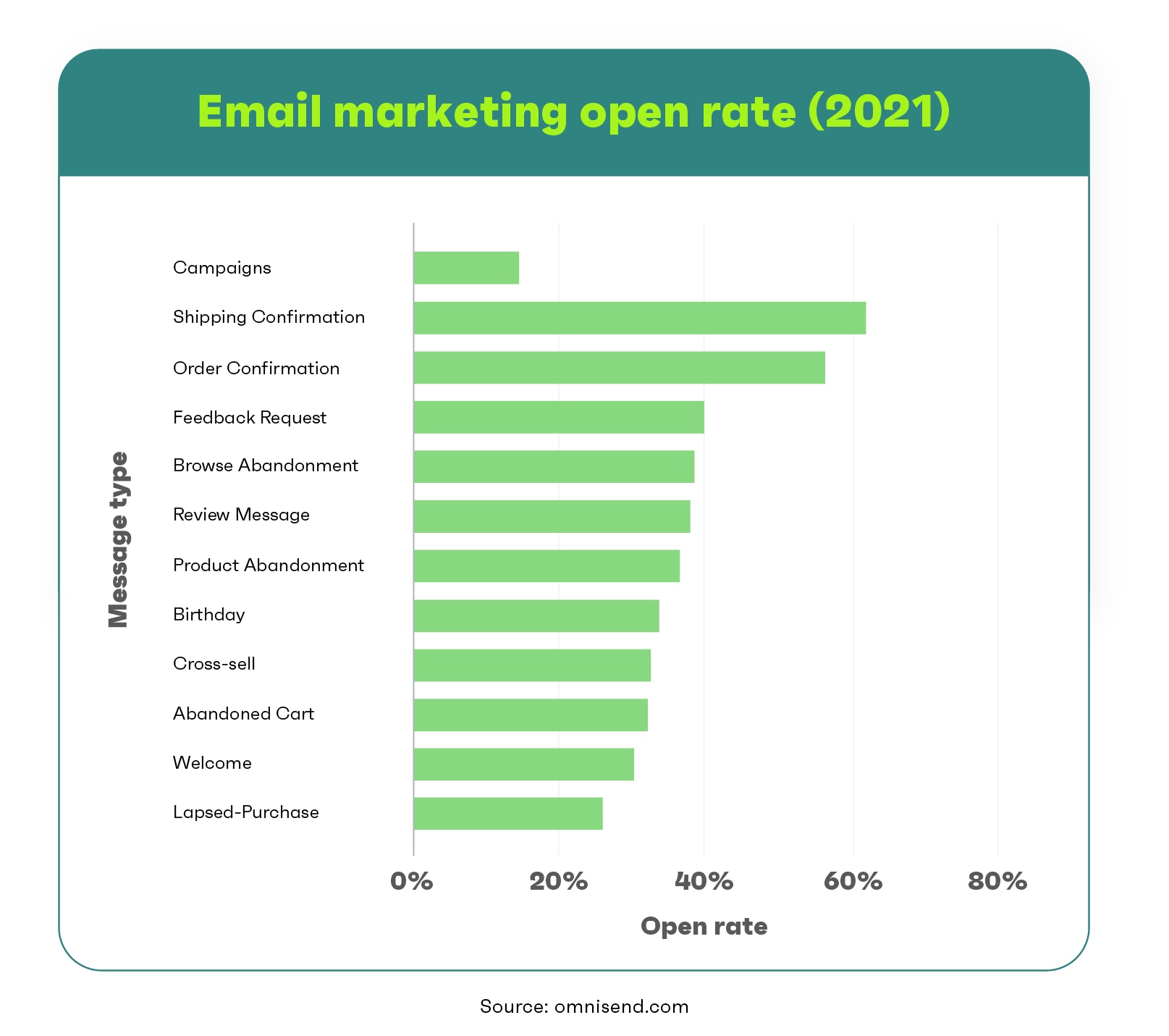
A 45% increase in open rates for promotional campaigns—what happened?
The answer, iOS 15. We sounded the alarm about the potential impact Apple’s iOS 15 release would have on open rates, and it appears that the impact is real. In the first eight months, before iOS 15, open rates were mostly consistent. Starting in September, as iOS 15 became available, and adoption grew, so did open rates.
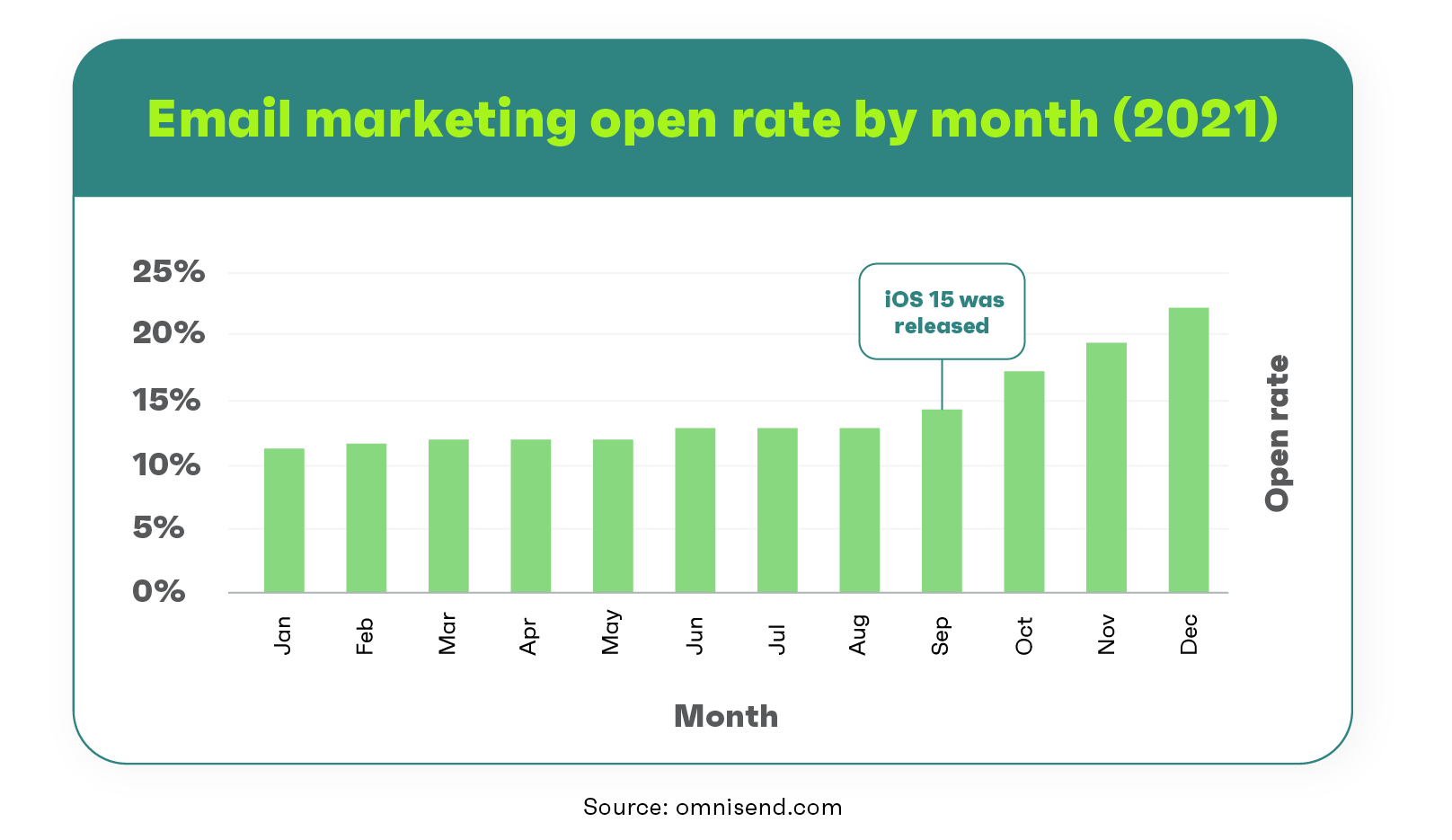
If iOS 15 impacted open rates, why was there a lesser increase for automated messages? It is likely due to automated messages already commanding very high open rates, leaving less room for an artificial lift than promotional campaigns.
| Message type | Open rate | YoY change % | Lift over campaigns |
| Campaigns | 14.73% | 45.02% | — |
| Abandoned cart | 32.10% | 8.30% | 117.93% |
| Birthday | 33.91% | 14.16% | 130.25% |
| Browse abandonment | 38.66% | 13.72% | 162.48% |
| Cross-sell | 32.51% | 2.10% | 120.75% |
| Feedback request | 39.95% | 7.41% | 171.26% |
| Lapsed-purchase | 26.15% | 7.38% | 77.57% |
| Product abandonment | 36.71% | -2.75% | 149.22% |
| Product review | 38.45% | 10.19% | 161.06% |
| Welcome | 30.45% | -0.78% | 106.75% |
| Order confirmation | 56.88% | 4.71% | 286.15% |
| Shipping confirmation | 62.37% | 3.01% | 323.48% |
Key Takeaways: Just because open rates may be inflated doesn’t mean they should be ignored. Ecommerce brands should:
2021 SMS marketing benchmarks
We’ve been witnessing the rise in SMS marketing over the past several years. It’s safe to say that 2021 was the year ecommerce brands fully got on board. After a 376% increase in promotional sends in 2020, ecommerce brands managed to send 75% more SMS in 2021.
Not only did promotional SMS campaign sends increase, but so did automated SMS messages. Omnisend merchants utilized Omnisend’s multichannel workflows and sent 258% more automated SMS than in 2020.
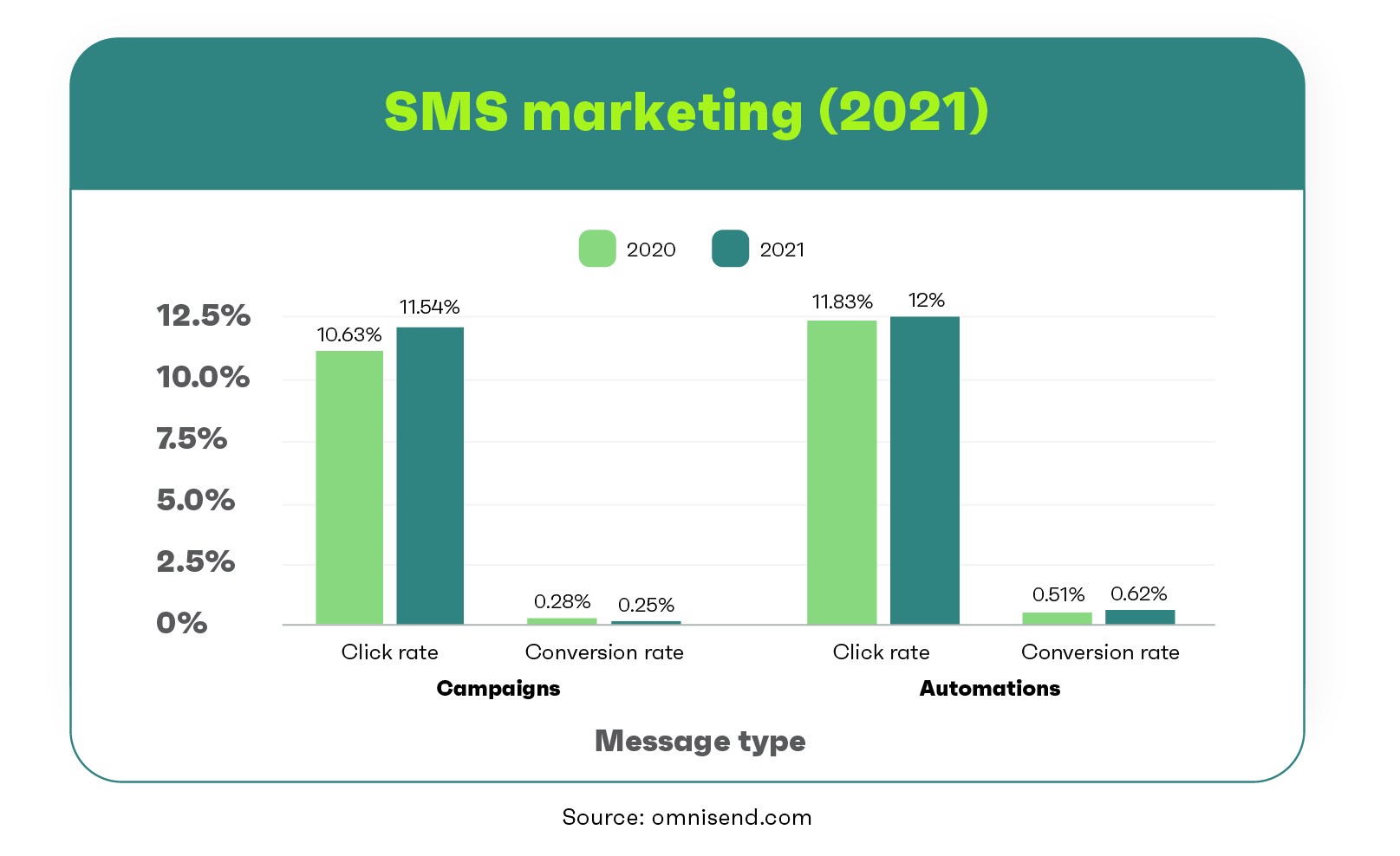
SMS conversion rates: Promotional SMS messages saw a slight decrease in conversion rate, dropping from 0.28% in 2020 to 0.25% in 2021. Decreases such as this are commonly seen with large increases in sends.
Automated SMS, on the other hand, not only increased in sends but saw conversion rates jump to 0.62%, a 20% YoY increase. Automated messages are behavior-based, making them more relevant, which explains why conversion rates for automated SMS are more than double those of promotional SMS campaigns.
SMS click rates: Click rates for promotional SMS increased from 10.6% in 2020 to 11.5% in 2021, while automated SMS increased slightly from 11.8% to 12%. The increased click rate for SMS messages is further proof they’re an effective marketing tool for engaging consumers and spurring action.
Overall, this increase in performance resulted in a 106% increase in orders compared to 2020.
Type
Click rate
YoY change %
Conversion rate
YoY change %
Campaigns
11.54%
8.5%
0.25%
-9.65%
Automation
12.00%
1.45%
0.62%
20.15%
Text messaging statistics from Black Friday and Cyber Monday
The BFCM shopping season is the litmus test for marketing tactics—if brands don’t find value in them, they won’t use them. This past holiday season, brands again found value in text message marketing. During the Cyber Ten, there was a 39% YoY increase in promotional SMS and a 21% increase in automated SMS, resulting in a 9% and 23% increase in orders, respectively.
Read more insights in our BFCM email, SMS, and push notification report.
Key takeaways: Like email, automated messages outperform their promotional campaign counterparts. Brand should focus on:
- Growing their SMS subscriber list by asking for mobile numbers at the same time as email addresses.
- Inserting SMS messages into automated workflows—especially the welcome and abandoned cart series.
- Using promotional SMS marketing campaigns to drive increased awareness of promotions and for time-sensitive offers like flash sales.
Push notification benchmarks for 2021
After a breakout year in 2020, web push messages continued their torrent ascension by sending nearly 396% more promotional campaign messages and 699% more automated messages than in 2020. These efforts resulted in a 171% increase in orders for Omnisend merchants in 2021.
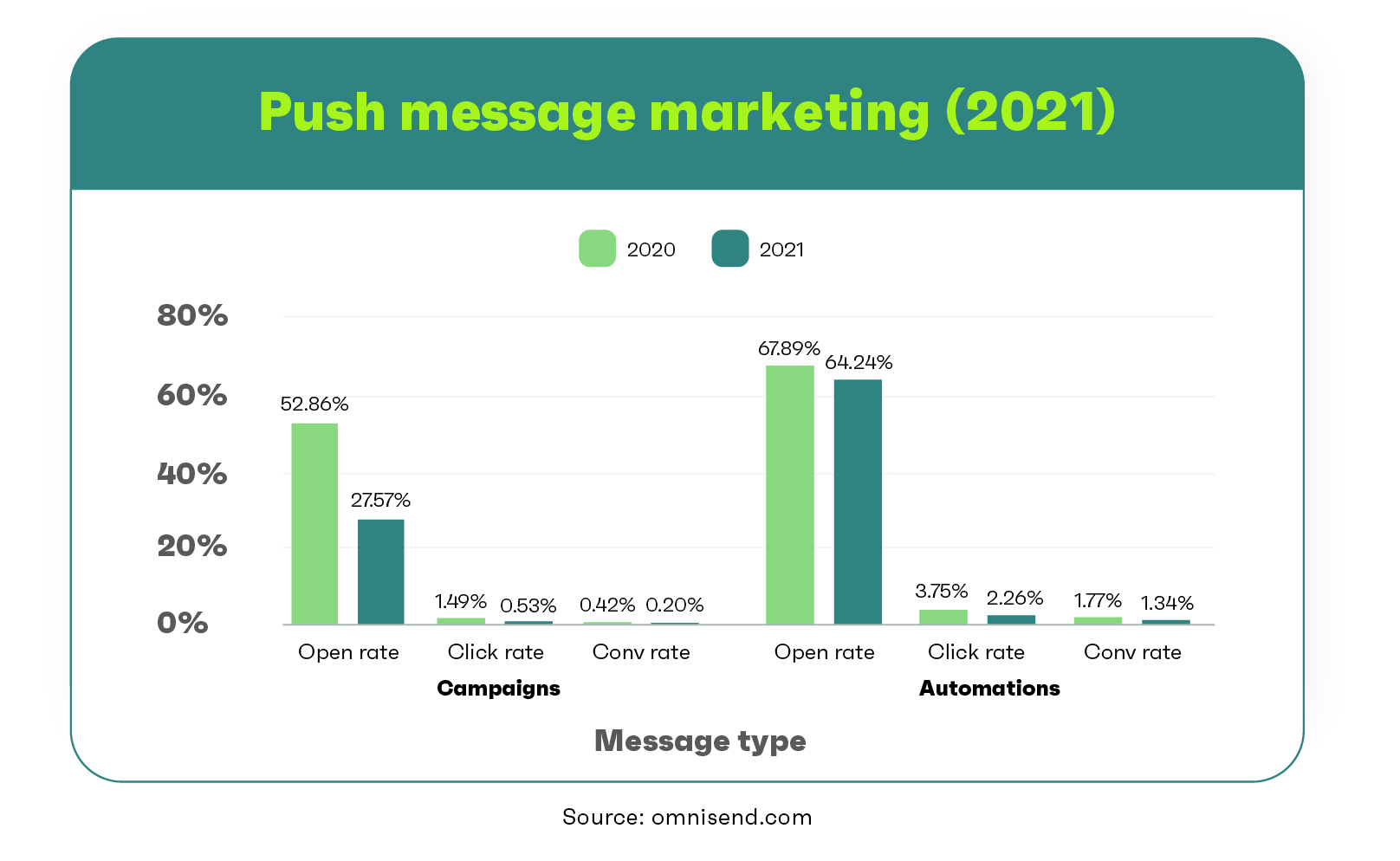
Web push open rates: Open rates for promotional push campaigns ended the year at a healthy 27.6%, even though it marks a 48% YoY decrease. And even with nearly two million sends, automated push messages still finished with a 64.2% open rate, a slight 5% decrease YoY. Overall, both numbers are healthy and show a lot of potential growth for ecommerce brands.
Web push conversion rates: Promotional push campaigns ended 2021 at 0.2%, a year-over-year decrease of 52%. While this may seem like a large drop, 38% of people who clicked on a message went on to make a purchase.
Like email and SMS, automated messages outperformed their promotional counterparts. The conversion rate for automated push messages ended the year at a strong 1.34%, even though this represents a 24% decrease from 2020.
Web push click rates: Promotional push campaigns ended 2021 with a 0.53% click rate, while automated messages finished at 2.3%. These represent a YoY decrease of 6% and 40%, respectively. Even with the YoY decreases, both numbers should still be considered healthy as up-and-coming marketing channels fluctuate more than established ones.
The push notification statistics are clear. With over 54 million messages sent in 2021, it’s safe to say that this is an opt-in channel consumers are increasingly interested in receiving brand communications through.
Type
Open rate
YoY change %
Click rate
YoY change %
Conversion rate
YoY change %
Campaigns
27.57%
-47.84%
0.53%
64.64%
0.20%
-51.85%
Automation
64.24%
-5.37%
2.26%
-39.78%
1.34%
-24.44%
Promotional push orders increased 139% this year, while automated push orders skyrocketed 504%.
Key takeaways: With a nearly 400% YoY increase in messages sent, ecommerce brands looking to stand out should implement a push message strategy in 2022. Considering nearly 30% of all clickers go on to make a purchase, brands should look to optimize these messages for clicks and include push messages in their omnichannel workflows—especially high-intent automation such as cart abandonment.
2021 recap and takeaways
2021 was an exciting year for marketers: Apple’s iOS 15 update forced ecommerce marketers to change how they value email marketing open rates, and unexpected supply chain challenges helped create an earlier and extended holiday shopping season.
Just as exciting was the performance and growth of opt-in marketing channels. Marketing automaton continued to perform at a high level, generating 29% of all email marketing orders on only 2.2% of the sends. And SMS and push messages continued to increase in adoption by both brands and consumers and generated more orders than ever.
Here are the main takeaways from 2021 and how brands can apply them to increase their sales in 2022.
- Analyzing all email statistics, automated messages prove yet again they can increase sales with less effort. Implement marketing automation, especially high-intent messages such as welcome, cart abandonment, and browse abandonment.
- Automated SMS and push message sends increased more than 100% YoY. Introduce workflow splits and incorporate SMS and web push notifications into their automated email workflows.
- SMS is a must-have opt-in channel. Focus on growing their SMS program by collecting mobile numbers along with email addresses.
- The growth of push message marketing is too great to ignore. Use them to stand out from competitors and capture sales.
Source link


